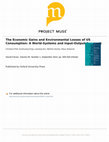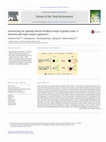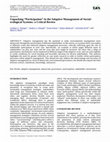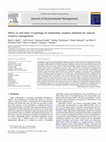Papers by Christina Prell

Although research has shown that countries’ world-systems positions can predict levels of polluti... more Although research has shown that countries’ world-systems positions can predict levels of pollution and wealth, there has been little research looking at how consumption in the core triggers both pollution and wealth elsewhere in the world economy. In this article, we track how consumption in the United States, a core country, triggers value added and pollution throughout global commodity chains. We track these distributions for all commodities and services consumed in the United States, then for six commodity groupings, and finally for two case studies, “Motor Vehicles” and “Wearing Apparel.” Our findings show how the production of commodities for US consumption tends to reify inequalities in the world-system: Larger shares of value added (in comparison to shares of pollution) are generally prompted within the core, whereas the opposite effect tends to be experienced in the non-core. We also discuss interesting exceptions to these general trends occurring at different levels of analysis. Finally, we draw special attention to China, the elephant in the room that exhibits both core and peripheral characteristics.

In this paper we investigate how structural patterns of international trade give rise to emission... more In this paper we investigate how structural patterns of international trade give rise to emissions inequalities across countries, and how such inequality in turn impact countries' mortality rates. We employ Multi-regional Input-Output analysis to distinguish between sulfur-dioxide (SO2) emissions produced within a country's boarders (production-based emissions) and emissions triggered by consumption in other countries (consumption-based emissions). We use social network analysis to capture countries' level of integration within the global trade network. We then apply the Prais-Winsten panel estimation technique to a panel data set across 172 countries over 20 years (1990–2010) to estimate the relationships between countries' level of integration and SO2 emissions, and the impact of trade integration and SO2 emission on mortality rates. Our findings suggest a positive, (log-) linear relationship between a country's level of integration and both kinds of emissions. In addition, although more integrated countries are mainly responsible for both forms of emissions , our findings indicate that they also tend to experience lower mortality rates. Our approach offers a unique combination of social network analysis with multiregional input-output analysis, which better operationalizes intuitive concepts about global trade and trade structure.

We examine carbon emission transfers via trade among countries over a 20-year period. A net trans... more We examine carbon emission transfers via trade among countries over a 20-year period. A net transfer of carbon emission means that the emission embodied in a country’s imports exceeds the emission embodied in exports. We consider a number of socio-economic drivers to explain variations in such net transfers across countries. Our findings show a U-shaped curvilinear relationship between countries’ GDP per capita and their net carbon transfer, suggesting that countries are
typically heavy net importers of carbon in early phases of economic development, become balanced or even net exporters of
carbon in middle stages of development, and then return to being heavy net importers of carbon in later stages of development. We reflect on these findings in the context of ecological modernization (EM) and ecological unequal exchange (EUE) theories, as well as the environmental Kuznets curve (EKC) hypothesis.

We examine carbon trade imbalances among 172 countries over a 10-year period (2000–2010). A carbo... more We examine carbon trade imbalances among 172 countries over a 10-year period (2000–2010). A carbon trade imbalance refers to the extent to which the carbon emissions embodied in a country's exports exceeds the emissions embodied in its imports. Although past research has considered how such imbalances coincide with variances in wealth and/or trade patterns, none have considered how such imbalances arise in the context of an evolving network structure. In this paper, we consider trade networks and carbon trade imbalances as co-evolving phenomena, and study these using an innovative combination of multi-regional input–output (MRIO) analysis with stochastic actor-oriented models (SAOMs). Our findings both challenge and support arguments made by ecological unequal exchange theory and the Gravity Model, and highlight the role emerging economies play in shaping network structure and the distribution of carbon trade balances overtime.
Incentive-based models for network formation link micro actions to changes in network structure. ... more Incentive-based models for network formation link micro actions to changes in network structure. Sociologists have extended these models on a number of fronts, but there remains a tendency to treat actors as homogenous agents and to disregard social theory. Drawing upon literature on the strategic use of networks for knowledge gains, we specify models exploring the co-evolution of networks and knowledge gains. Our findings suggest that pursuing transitive ties is the most successful strategy, as more reciprocity and cycling result from this pursuit, thus encouraging learning across the network. We also discuss the role of network size, global network structure, and parameter strength in actors’ attainment of knowledge resources.

Land-use change is increasingly driven by global trade. The term “telecoupling” has been gaining ... more Land-use change is increasingly driven by global trade. The term “telecoupling” has been gaining ground as a
means to describe how human actions in one part of the world can have spatially distant impacts on land and
land-use in another. These interactions can, over time, create both direct and spatially distant feedback loops,
inwhich human activity and land use mutually impact one another over great expanses. In this paper, we develop
an analytical framework to clarify spatially distant feedbacks in the case of land use and global trade. We use
an innovative mix ofmulti-regional input-output (MRIO) analysis and stochastic actor-orientedmodels (SAOMs)
for analyzing the co-evolution of changes in trade network patterns with those of land use, as embodied in trade.
Our results indicate that the formation of trade ties and changes in embodied land use mutually impact one another,
and further, that these changes are linked to disparities in countries'wealth. Through identifying this feedback
loop, our results support ongoing discussions about the unequal trade patterns between rich and poor
countries that result in uneven distributions of negative environmental impacts. Finally, evidence for this feedback
loop is present even when controlling for a number of underlying mechanisms, such as countries' land endowments,
their geographical distance from one another, and a number of endogenous network tendencies.
Journal of Computer-mediated Communication, 2003
This paper draws upon an ongoing study pertaining to the early development of one component of a ... more This paper draws upon an ongoing study pertaining to the early development of one component of a community network in the city of Troy, New York, USA. The component under study is that of a database to be distributed via a community network. Community networking literature ...

Adaptive management has the potential to make environmental management more democratic through th... more Adaptive management has the potential to make environmental management more democratic through the involvement of different stakeholders. In this article, we examine three case studies at different scales that followed adaptive management processes, critically reflecting upon the role of stakeholder participation in each case. Specifically, we examine at which stages different types of stakeholders can play key roles and the ways that each might be involved. We show that a range of participatory mechanisms can be employed at different stages of the adaptive cycle, and can work together to create conditions for social learning and favorable outcomes for diverse stakeholders. This analysis highlights the need for greater reflection on case study research in order to further refine participatory processes within adaptive management. This should not only address the shortcomings and successes of adaptive management as a form of democratic environmental governance, but should also unpack the links between science, institutions, knowledge, and power.
1 This problem is related to notions of a preanalytic vision (Schumpeter) or paradigm (Kuhn) wher... more 1 This problem is related to notions of a preanalytic vision (Schumpeter) or paradigm (Kuhn) where the researcher's perception predetermines which problems are perceived, how these problems are perceived, and approaches towards research more generally.
Society & Natural Resources, 2009

Journal of Environmental Management, 2009
Stakeholder analysis means many things to different people. Various methods and approaches have b... more Stakeholder analysis means many things to different people. Various methods and approaches have been developed in different fields for different purposes, leading to confusion over the concept and practice of stakeholder analysis. This paper asks how and why stakeholder analysis should be conducted for participatory natural resource management research. This is achieved by reviewing the development of stakeholder analysis in business management, development and natural resource management. The normative and instrumental theoretical basis for stakeholder analysis is discussed, and a stakeholder analysis typology is proposed. This consists of methods for: i) identifying stakeholders; ii) differentiating between and categorising stakeholders; and iii) investigating relationships between stakeholders. The range of methods that can be used to carry out each type of analysis is reviewed. These methods and approaches are then illustrated through a series of case studies funded through the Rural Economy and Land Use (RELU) programme. These case studies show the wide range of participatory and non-participatory methods that can be used, and discuss some of the challenges and limitations of existing methods for stakeholder analysis. The case studies also propose new tools and combinations of methods that can more effectively identify and categorise stakeholders and help understand their inter-relationships.
Doubles (added by others) by Christina Prell

ABSTRACT For much of the twentieth century natural resource management centered on efforts to con... more ABSTRACT For much of the twentieth century natural resource management centered on efforts to control nature in order to harvest products from it, while reducing risks to society. The central tenet was to achieve predictable outcomes, a strategy that almost invariably led to reduced biological diversity and a reduction of the range of variation in natural systems. However, reduced diversity, in turn, tends to create more sensitive systems, both ecological and social (Levin, 1999), and examples of this today are the highly controlled systems of conventional agriculture and forestry that are experiencing increasing problems, fighting pest outbreaks and declining populations of natural pollinators (Chapin et al., 2000; Lundberg and Moberg, 2003). From the 1970s onwards (Holling, 1973, 1978), it has been suggested that such attempts to control highly complex and non-linear systems inevitably lead to surprises and/or societal and environmental crises (Holling and Meffe, 1995). On the basis of these arguments, conventional resource management, or command-and-control management as it is often referred to, has been heavily criticized (Holling, 1973; Holling et al., 1995; Wondolleck and Yaffee, 2000; Folke et al., 2005, among many others) and several approaches have been proposed to overcome some of its limitations. These include, among others, adaptive management (Holling, 1978), cooperative management (Pinkerton, 1989; Jentoft, 2000), collaborative management (Borrini-Feyerabend and Borrini, 1996; Wondolleck and Yaffee, 2000), and adaptive co-management (Ruitenbeek and Cartier, 2001; Olsson et al., 2004a). These concepts share many similarities and readers are referred to Folke et al. (2005) and Armitage et al. (2008a, 2008b) for more in-depth reviews.
Uploads
Papers by Christina Prell
typically heavy net importers of carbon in early phases of economic development, become balanced or even net exporters of
carbon in middle stages of development, and then return to being heavy net importers of carbon in later stages of development. We reflect on these findings in the context of ecological modernization (EM) and ecological unequal exchange (EUE) theories, as well as the environmental Kuznets curve (EKC) hypothesis.
means to describe how human actions in one part of the world can have spatially distant impacts on land and
land-use in another. These interactions can, over time, create both direct and spatially distant feedback loops,
inwhich human activity and land use mutually impact one another over great expanses. In this paper, we develop
an analytical framework to clarify spatially distant feedbacks in the case of land use and global trade. We use
an innovative mix ofmulti-regional input-output (MRIO) analysis and stochastic actor-orientedmodels (SAOMs)
for analyzing the co-evolution of changes in trade network patterns with those of land use, as embodied in trade.
Our results indicate that the formation of trade ties and changes in embodied land use mutually impact one another,
and further, that these changes are linked to disparities in countries'wealth. Through identifying this feedback
loop, our results support ongoing discussions about the unequal trade patterns between rich and poor
countries that result in uneven distributions of negative environmental impacts. Finally, evidence for this feedback
loop is present even when controlling for a number of underlying mechanisms, such as countries' land endowments,
their geographical distance from one another, and a number of endogenous network tendencies.
Doubles (added by others) by Christina Prell
typically heavy net importers of carbon in early phases of economic development, become balanced or even net exporters of
carbon in middle stages of development, and then return to being heavy net importers of carbon in later stages of development. We reflect on these findings in the context of ecological modernization (EM) and ecological unequal exchange (EUE) theories, as well as the environmental Kuznets curve (EKC) hypothesis.
means to describe how human actions in one part of the world can have spatially distant impacts on land and
land-use in another. These interactions can, over time, create both direct and spatially distant feedback loops,
inwhich human activity and land use mutually impact one another over great expanses. In this paper, we develop
an analytical framework to clarify spatially distant feedbacks in the case of land use and global trade. We use
an innovative mix ofmulti-regional input-output (MRIO) analysis and stochastic actor-orientedmodels (SAOMs)
for analyzing the co-evolution of changes in trade network patterns with those of land use, as embodied in trade.
Our results indicate that the formation of trade ties and changes in embodied land use mutually impact one another,
and further, that these changes are linked to disparities in countries'wealth. Through identifying this feedback
loop, our results support ongoing discussions about the unequal trade patterns between rich and poor
countries that result in uneven distributions of negative environmental impacts. Finally, evidence for this feedback
loop is present even when controlling for a number of underlying mechanisms, such as countries' land endowments,
their geographical distance from one another, and a number of endogenous network tendencies.